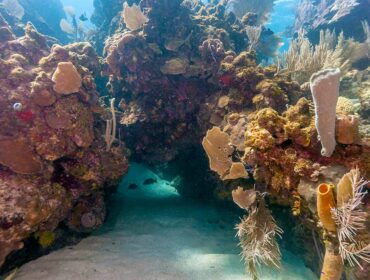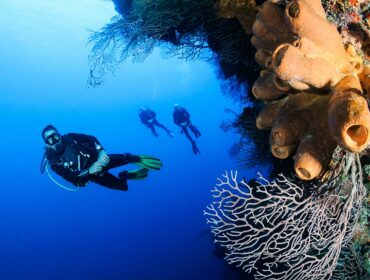Dive Sites are often named after oceanic landforms or geographical terrain features that the site is located on. Thus it become helpful for Scuba Divers to understand the various terminologies to help them better understand their dive site. Below is a list of common underwater terrain features used to describe scuba diving sites.
Seamount
Seamounts are undersea mountains rising from the bottom of the sea but do not break the water’s surface. Seamounts are always isolated elevations. Geologists classify an elevation to be a seamount when the feature rises 1000 meters (3280 ft) or more from the seafloor. As these geographical features are isolated elevations in the deep sea, Seamounts provide habitats and spawning grounds for larger animals, including numerous fish making them excellent dive sites.
Knolls
A Knoll is a smaller version of the seamount that rises from less that 1000m from the seafloor. A Knoll can be compared to an underwater hill, with a limited area on its summit for it to be classified as a Knoll. Knoll’s too are often covered in coral or seagrass, making them important biodiversity concentration zones. Smaller fish and fish cleaning stations are often located on these sites drawing in larger pelagics for feeding, grooming or to shelter from the current.
Pinnacle
Pinnacles are another form of seamount, but are smaller isolated pillar-like elevations rising off the seafloor. Pinnacles make highly popular dive sites, as owing to their limited area, the concentration of marine life that inhabit pinnacles is extremely high making them akin to an oasis in the deep sea. You often find smaller reef fish and other creatures that only inhabit reefs living on the pinnacle and divers get the unique opportunity to observe larger pelagic fish, like barracuda, tuna and shoals of grouper that often linger around pinnacles that prey on the smaller fish.
Underwater Ridge
Ocean Ridges or underwater ridges comprise of a series of underwater mountains (unlike a seamount which is a single or isolated elevation) separated by rift valleys. Ridges are formed by volcanic activity and formed by the cooling of lava uplifting the seafloor to form the ridge.
Wall
A Wall is essentially an underwater cliff face, of either coral or rock, more commonly a reef edge that runs vertically, usually running from shallow to deep and drops off suddenly into the depths of the ocean. Walls are usually found around islands or continental coastlines where the sea bed which gradually slopes downwards, suddenly drops to the depths of the ocean. Diving a wall can be very exhilarating and requires good buoyancy control because there is no seabed to prevent the diver descending too deep. Reef walls usually have strong upward or downward currents running along the wall as the current from the deep hits the vertical rock face and rises, making it extremely challenging to navigate and swim which adds to the challenge
Gully
A gully is a landform created by fast moving underwater currents eroding sharply into sea bed. These may have also been caused by the flow of lava over the sea bed, similar to a lava tube. Gullies resemble large ditches or small valleys, but are meters to tens of meters in depth and width. Gullies make intersting dive sites as there are often a wide variety of fish and marine life that inhabit these depressions to escape the ocean currents.
Gorge
A Gorge is essentially a much larger version of a Gully, and is an underwater canyon or a deep ravine between cliffs. Gorges are essentially formed by a rift between two undersea mountains/elevations due to the shifting of the earth’s crust. Diving a gorge is a unique experience similar to wall diving, and currents are unpredictable in gorges, but are often plankton rich, drawing all kinds of creatures to it.



